Portland Public Schools Finds a Better Way to Configure PCs
When it comes to academics, Portland Public Schools hardly has an image problem. Statewide test scores were up in almost every category this past year, and two PPS high schools made U.S. News & World Report’s Top 10 list for the 287 Oregon high schools the magazine reviewed.
While Portland’s schools and the city itself enjoy a positive image, especially among people who want an urban lifestyle without the hustle-bustle of New York City or Los Angeles, PPS did have an issue when it came to its computer images. Ryan Whitman-Morales, director of technical operations for PPS, says it used to take up to four IT pros a few days to image new PCs using a cumbersome and labor-intensive process. The staff created the images by hand and sent them to CDW via FTP server or by mailing DVDs. CDW technicians manually uploaded the images to new PCs before sending them back to PPS.
All of that changed a few years ago when PPS set up a site-to-site virtual private network (VPN) tunnel from its headquarters to CDW. Now PPS staff create images in Microsoft System Center Configuration Manager (SCCM) software, which transmits them to an SCCM server at CDW’s secondary configuration and distribution center in North Las Vegas, Nev. CDW technicians load the images onto new PCs within minutes, apply the customer’s asset tag and then box and ship the hardware directly to the right PPS school. Once the PCs arrive, CDW’s third-party service provider unpacks and sets up the PCs. All the teachers need to do is set aside space for the new computers.
“This new setup saves the district hundreds of thousands of dollars a year in labor and shipping costs and storage space. We no longer have to store computers on pallet after pallet; they just get shipped directly to the school,” says Whitman-Morales. “Plus, it lets our IT team spend more time out in the field working with teachers and students where they can be most useful.”
Phil Sammons, configuration services trainer for CDW, adds that PPS uses SCCM for more than just creating and transmitting images. “SCCM also saves money on software licensing because PPS can customize jobs to provide just the applications that are necessary for a specific group of users,” Sammons explains.
 “This new setup saves the district hundreds of thousands of dollars a year in labor and shipping costs and storage space.”
“This new setup saves the district hundreds of thousands of dollars a year in labor and shipping costs and storage space.”— Ryan Whitman-Morales, Director of Technical Operations, Portland Public Schools
CREDIT: Robbie McClaran
Laying the Groundwork
Today, the PC configuration process is as seamless as connecting a VPN appliance and SCCM server at CDW back to PPS. But the journey to this new system dates back about seven or eight years.
Jonathan Vail, user experience management lead for PPS, says the transition started when the district upgraded from its old network to Microsoft Active Directory. Back then, PPS could afford to deploy file, print and configuration services to only 36 of its 85 locations, so most of the sites were not managed properly.
To make it even more complicated, under the old system, each school location had its own Domain Name System (DNS) site. For example, Cleveland High School was Cleveland.pps.net and Benson High School was benson.pps.net.
At sites with the old system, IT pros had to configure each workstation for that specific site. If a workstation was imaged for one of the nonmanaged sites, it also had to be configured as such. CDW technicians performed all of this work manually with a menu system during the scripted imaging process.
Vail says the move to Active Directory enabled PPS to use a single DNS name. That meant imaged machines could function at any site, and setup technicians no longer had to follow a set of special instructions. Binding every machine to Active Directory drastically eased network management.
“By moving to Active Directory and then SCCM, we had a more mature set of tools and uniform configurations,” Vail explains. “As network connectivity became less expensive over the years, standing up the direct network connection to CDW was no longer cost-prohibitive and, with SCCM, was much easier to manage than the old server project.”
Adam Seitz, systems administrator for PPS, says SCCM has evolved over the past several years, especially when it comes to security. “The latest version gives us the ability to stack virus policies,” Seitz notes. “We can take the most secure ones and apply them to the machines we are imaging.”
The Network Connection
While deploying Active Directory and SCCM were critical, nothing would have moved forward without a network upgrade.
Mark Lancaster, network administrator supervisor for PPS, says the district upgraded bandwidth to accommodate the additional technologies. The city of Portland leases the district bandwidth on its 10 Gigabit Metro Ethernet fiber backbone.
“The city’s network is really great,” Lancaster says. “It basically serves as a local fiber ring in which we transmit IP traffic.”
Once the bandwidth upgrades were in place, Lancaster worked with CDW to configure the VPN tunnel using Cisco ASA appliances. Keith Walberg, the CDW configuration center supervisor who worked closely with PPS to establish the network link, says the process was fairly straightforward.
PPS configured a Cisco ASA 5505 VPN appliance and SCCM server and shipped them to the Las Vegas data center. Then CDW racked them, installed the cabling and connected the server to the VPN.
“We did initial testing, and they gave us some feedback, and then we were up and running in no time,” Walberg says.
Whitman-Morales says the new setup helps the district get new PCs into the hands of students, teachers and staff.
“I worked in shops that did their own imaging by hand,” he says. “We would have to image something like 20,000 machines and each one would take 45 minutes to an hour.”
The imaging system was especially useful when PPS had to reimage 14,000 machines as part of a Windows XP migration. As of late fall, the district was about 84 percent of the way done, largely because of the quality of the imaging system and the power of the city of Portland’s fiber infrastructure.
“It doesn’t matter if it’s during busy times like last spring, or if we get a large donation and need to image new machines, we now have the infrastructure, tools and network connection in place to quickly image computers and upload software any time we need them,” concludes Whitman-Morales.









